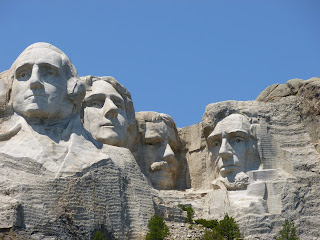 |
| Trail End |
 |
| Frank and Julia |
Best part of our stop here was that Julia and Frank, our good friends from Fort Collins, Colorado spent a couple of days with us on their way to Montana.
 |
| Crazy Horse Monument |
Leaving Wyoming, we entered the Black Hills of South Dakota, so named because the dark green pines seen from a distance look black. Don’t be fooled. The area is green and gorgeous.
 |
| Crazy Horse Model |
 |
| All of Mount Rushmore would fit in section behind his face |
 |
| Got food? |
 |
| One of a herd of 1,300 in the park |
 |
| One of the wider tunnels |
 |
| The eye of the needle |
 |
| Sylvan Lake |
Everyone has seen pictures of this national monument but to see it in person is quite breathtaking. The faces of the 4 presidents - Washington, Jefferson, Teddy Roosevelt and Lincoln - are 60 feet tall. Washington has the longest nose at 21 feet; the others are 20 feet long. As with Crazy Horse, most of the work is done with dynamite, blasting the stone away to within 2 inches of the finished surface. Unlike Crazy Horse, Mt. Rushmore was created between 1927 and 1941, and only 6 years involved actual carving. The difference is that Crazy Horse refuses government funds and employs only 12 full time workers on the mountain; it may forever be a work in progress. Gutzon Borglum, the man who carved the Confederate Memorial on Stone Mountain in Georgia was the master artist behind Mount Rushmore. Believe it or not, the project originated with the hope of drawing tourists to the Black Hills. Did it ever succeed!
 |
| Auto mania downtown Sioux Falls |
 |
| The falls in Sioux Falls |
 |
| The falls in Sioux Falls |
Now we will cross Minnesota into Wisconsin.
TRAVEL TIP: If you do go to the Black Hills, plan to stay in Custer not Keystone. It is much more convenient for visiting the state park and Crazy Horse, and easy to get to Mount Rushmore.


No comments:
Post a Comment